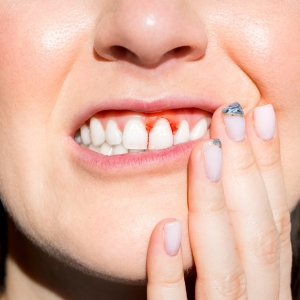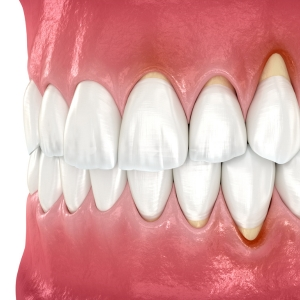While a perfectly straight smile is valued, the truth is that very few people naturally have one. Most people have at least some form of malocclusion, or misalignment, which is why orthodontics are so popular. Dr. Afroz Burges, Family and Cosmetic Dentistry specializes in traditional and alternative orthodontic treatment options.
Orthodontic treatment has long been celebrated for its transformative effect on smiles and oral health. However, despite all of the advantages of these treatments, research indicates that there may be a link between orthodontic treatment and gum recession.
In this article, we’ll explore the potential causes, preventative measures, and the importance of a collaborative approach between patients, orthodontists, and periodontists.

Gum recession is a fairly common oral health concern that occurs when the gum tissue surrounding the teeth recedes, exposing more of the tooth or tooth root. This can lead to an increase in tooth sensitivity, aesthetic concerns, and, in more severe cases, can compromise the stability of the teeth.
Gum recession is a gradual process, and its symptoms may develop over time. It's essential to be vigilant about changes in your oral health to detect gum recession early. Here are common symptoms of gum recession:
One of the first indications that you are experiencing gum recession is longer teeth. As the gums recede, more of the tooth is exposed. Eventually, the roots will become exposed, which leads to increased tooth sensitivity.
Receding gums also cause the dentin layer of the tooth to be exposed. This layer contains nerve endings, leading to an increase in sensitivity to certain foods and temperature changes. Gums may also become sensitive and tender.
As the gums recede, small notches/grooves appear near the gumline of the affected teeth. These are referred to as abfractions. In addition, exposed tooth roots often have a different color than the enamel-covered portion of the teeth.
While some bleeding may be normal due to hormonal changes and environmental factors, gum recession can make gums more susceptible to irritation and inflammation, which can lead to bleeding when brushing and flossing.
Bacteria may accumulate in the spaces created by receding gums, which can lead to bad breath.
It is important to note that gum recession is often a gradual process and, in some cases, patients may not experience any obvious symptoms. Regular dental visits are critical for early detection and intervention to prevent further recession and complications.

Orthodontic treatments, such as braces and other corrective appliances, are designed to improve the alignment of teeth and enhance oral function. While these interventions are generally beneficial, they can contribute to gum recession under certain circumstances.
If you want to understand how orthodontics can cause gum recession, you must consider the following:
Orthodontic appliances work by applying controlled, gradual pressure on the teeth, shifting them into their desired position. However, excessive force or uneven pressure can lead to gum recession.
In some cases, the pressure can cause the teeth to move faster than the surrounding bone and soft tissue can adapt. This rapid or aggressive movement can strain the supporting structures, potentially leading to gum recession.
The brackets and wires of traditional braces create additional nooks and crannies in the mouth, which can make brushing and flossing more difficult. If optimal oral hygiene is not maintained, plaque and bacteria can accumulate around the braces, leading to gingivitis. If left untreated, gingivitis can advance to periodontitis, which is a contributor to gum recession.
Every patient’s oral anatomy is different, as well as their gums response to orthodontic treatment. Some are more susceptible to gum recession than others due to a variety of factors including genetics, thin gum tissue, or pre-existing periodontal conditions.
The brackets and wires of traditional braces can contribute to irritation and friction against the gums. This irritation, especially combined with inadequate oral hygiene, can lead to gum recession.
In some cases, the structure of the jaw or arrangement of teeth can limit the space that teeth have to move. Orthodontic adjustments to create this space may put too much pressure on the gums, leading to gum recession.
While research has found a link between orthodontic treatment and gum recession, the goal is to create a balance that allows patients to achieve a perfect smile without impacting their gum health. This requires a multifaceted approach that prioritizes collaboration, education, and customization.
Orthodontists and periodontists should work closely, exchanging information and insights to ensure a holistic understanding of the patient’s oral health. Periodontal assessments before, during, and after orthodontic treatment can identify risk factors and help to create a proactive approach to preventive care.
Informed patients are better equipped to take an active role in their oral health. Patients should receive comprehensive education on the importance of oral hygiene, recognizing the signs of gum recession, and the importance of regular check-ups.
Practical guidance on maintaining proper oral hygiene with braces, including specialized brushes and flossing techniques, can reduce the risk of gum-related complications.
Every patient has unique circumstances, which means that it is important to customize the treatment plan. Orthodontists should consider several factors including:
This customized approach will reduce the risk of gum recession during orthodontic treatment.
In navigating the link between orthodontics and gum recession, a comprehensive understanding of the causes and preventive measures is crucial. The collaborative efforts of orthodontists and periodontists, coupled with patient education and customized treatment plans, can pave the way for a harmonious balance. Ultimately, achieving a beautiful, straight smile need not come at the expense of gum health.
Dr. Burges works with her patients to create a strategic and collaborative approach, allowing them to confidently embark on their orthodontic journey with an understanding that their overall oral health is prioritize and safeguarded.